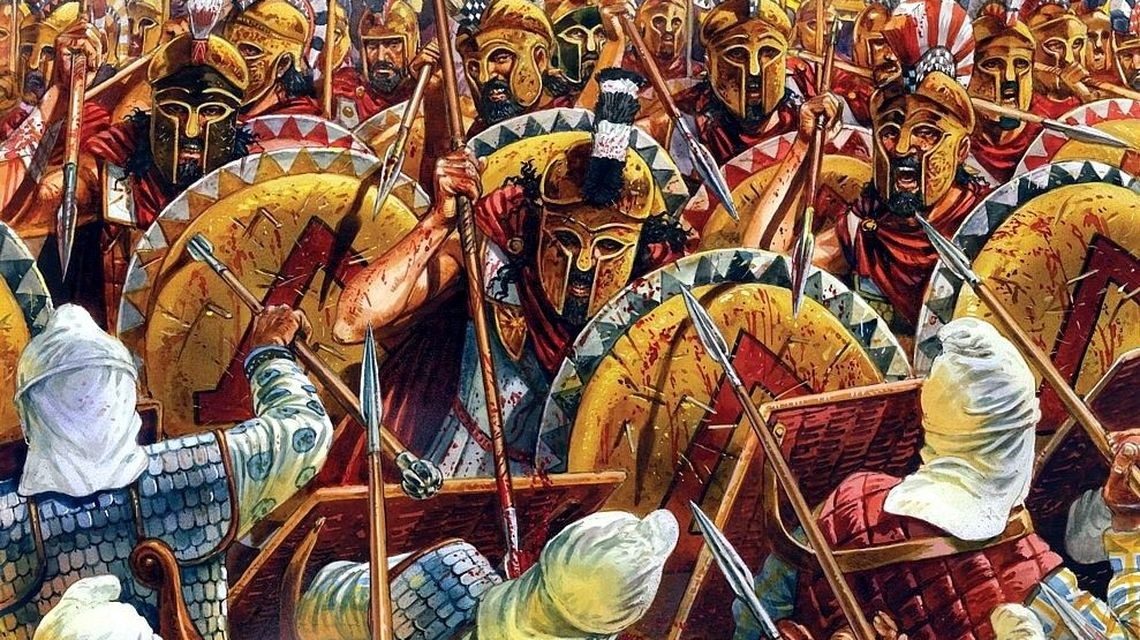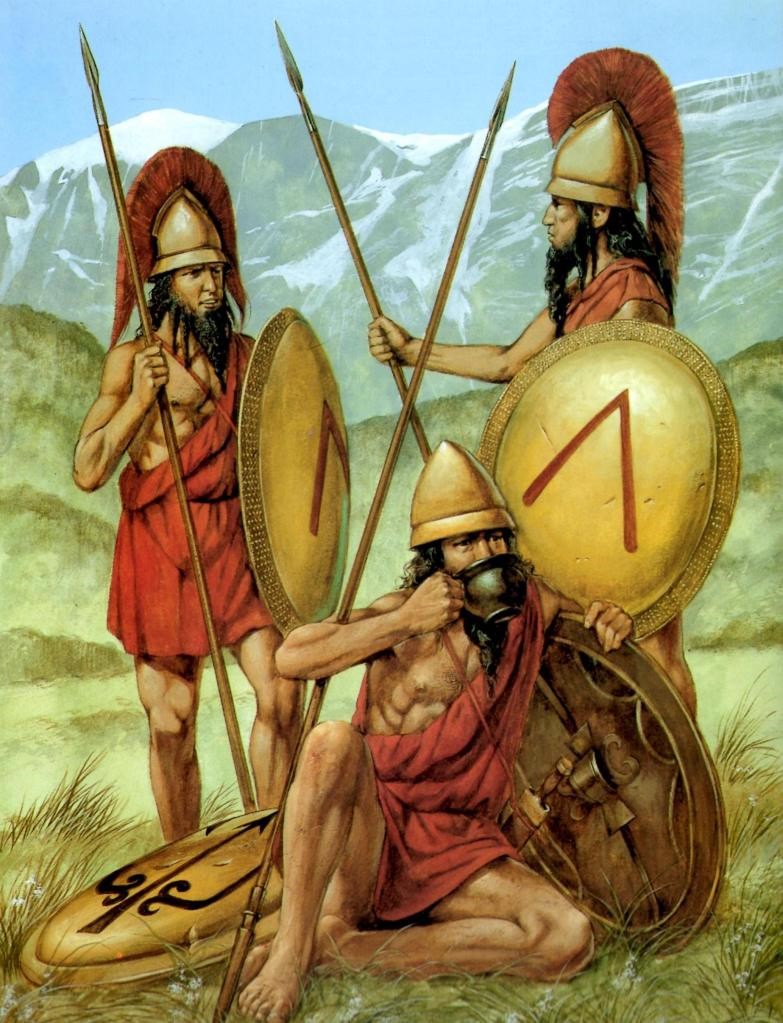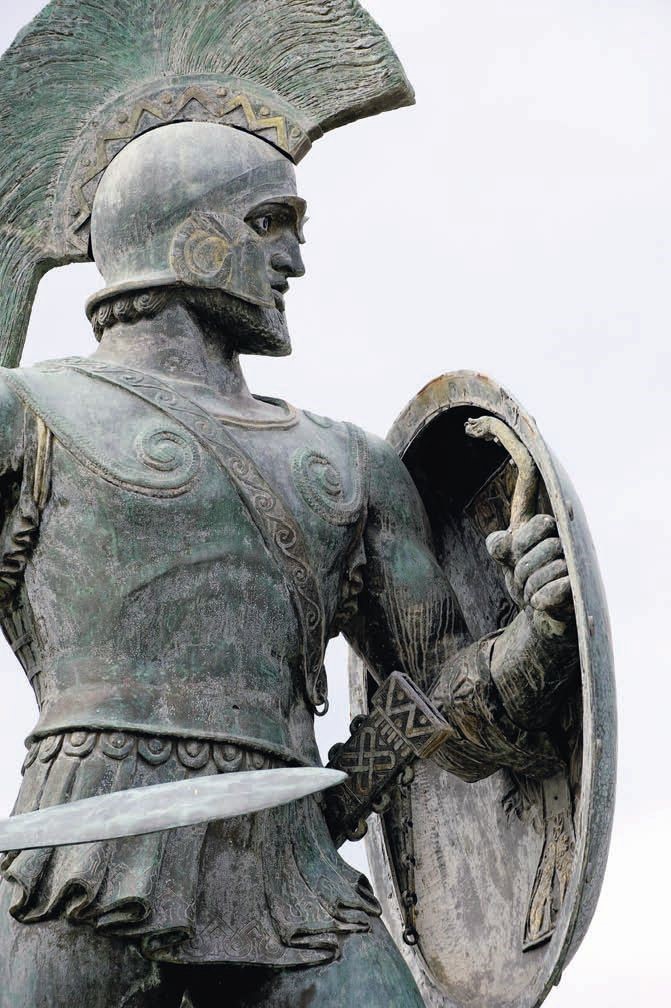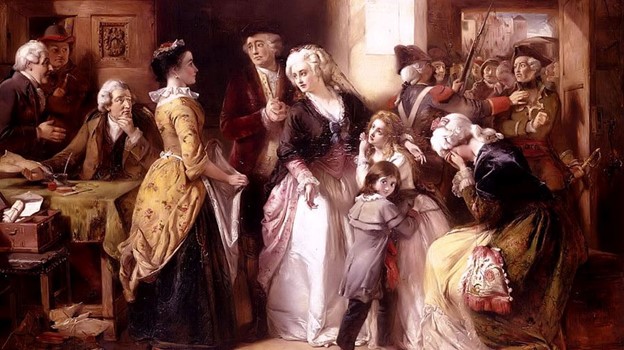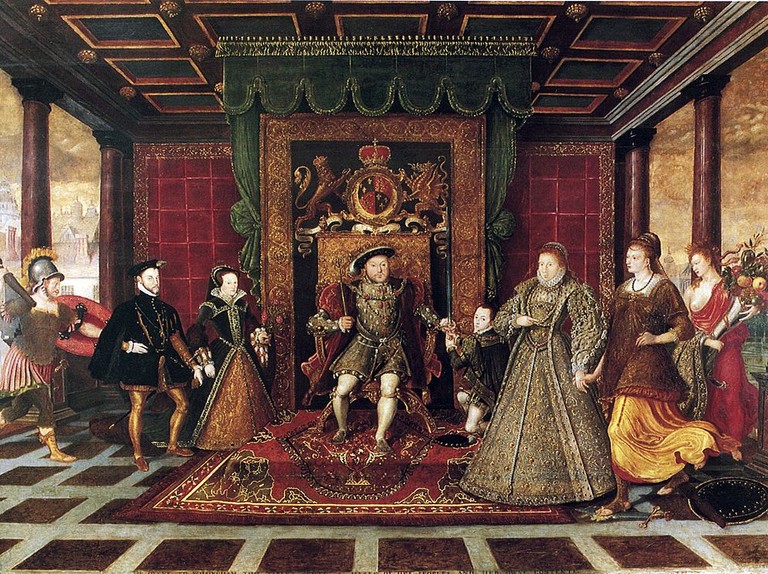In the middle of the 7th century BC, a new type of tactical instrument is generalizing in the Greek world: a phalanx of heavy-armed pedestrians, the hoplites. The name “hoplites” derives from the collective noun “ta hopla, panoplia”, meaning the totality of the offensive and defensive weapons that each soldier is wearing in this formation: the helmet, the plaid, the greaves (shin guards) to protect the tibia and the calves, the lance and the short sword and finally the shield, all weighing nearly 45 kilograms of metal; the name “phalanx” of the compact and articulated pedestrian formation inexorably advancing towards the defense lines of the enemy, uses the image of the finger joints, which are indispensable to each other.
The phalanx is typified by a compact layout and action that ultimately depend on a new type of shield, datable to the 7th century BC. Relatively small, round, it has two grip handles, one in the center of the shield and the other in the left edge of the shield. Carried on the right hand, the shield is stretched on the arm to the elbow and grasped by the edge handle, the so-called “antilabe”.
Thus, the shields no longer protect each of the soldiers, but they form a kind of common shell, in which each shield protects the right flank of the bearer and the left flank of his line neighbor. This is basically a new kind of warfare; the main effort no longer belongs to elite warriors, followed with more or less effectiveness by their formation, but belongs to compact formation of soldiers advancing in close lines, dictated by a minstrel, “auletes”, who chants a march from his double whistle.
Sparta, from Menelaos to Lycurgus
Of course, elements of this new syntax of the war have appeared since the early epochs: ancient historians of ancient Greece often invoke a tradition that goes up to the Homeric epic. But the conjunction that leads to the generalization of the hoplite phalanx achieves an ideal of equality and reciprocity on the battlefield, extended from a military and aristocratic elite to the whole armed people.
The classic case, clearly showing and demonstrating the homology of these innovations at all levels – social, political, military and mentality – remains Sparta of the 7th century BC. The proeminent city-state of Sparta, dominating the plain of Laconia in the Peloponnese, was famous since the Homeric epic, where is described as being ruled by Menelaos Atrides himself, brother of Agamemnon and husband Elena left for the Trojan prince Paris / Alexandros.
In fact, Sparta itself doesn’t seem to have been the heart of bronze civilization. The true glory of Sparta is related to the generalization of iron metallurgy, concurrent with the diffusion of epics, at the beginning of the first millennium BC: the territory that the city controls is remarkably rich in iron ore.
Due to this, but also due to the fertility of Laconia, as well as other less obvious circumstances, Sparta still distinguishes itself during the first centuries of crystallization of the Greek cities through the totally unusual dimensions of the territory it controls: towards the middle of the 6th century BC, after the conquest of Messenia, Sparta ruled with the words of Thucydides, two fifths of the Peloponnese (Thuc., 1.10.2), that is, about 8,500 km2. Athens, which was the only city of the territory comparable as surface, was dominating the Attica with only 2,500 km2.
The intelligible sequence of the events of the social-political history of Sparta is evoked by most of the ancient sources starting from a state of “dusnomia”, internal discord, followed by the reforms attributed to Lycurgus, who established good order, the eunomia, for which the city of Lacedemone will be greatly praised in the historical and philosophical literature of antiquity and not only.
The Spartan mirage and its succession
This is in fact – along with the almost total absence of local written sources – the main obstacle to the restoration, with a reasonable degree of certainty, of the first centuries of Sparta’s history.
Excepting two poets of the 7th century BC, both of whom creating in Sparta, although tradition claims that both came from micro-Asian Greece – Tyrtaeus of Miletus and Alcman of Sardis, the capital of the Lydian kingdom – all the information from written sources we have come from authors far too distant not only in time, but very often also in space.
https://www.youtube.com/watch?v=HdNn5TZu6R8
The attention they give to Sparta is a sub-product of its idealization as a “well-ordered” city-state – that is, ultimately, non-democratic. In the clash of opinions and ideas that precede, accompany and finally follow the Peloponnesian War, the model of an ideal fortress dominated by an ascetic warrior elite animated by a common ethos sustainably substitutes the real Spartan city and under this idealized aspect becomes the political ideal of all oligarchies.
Furthermore, the Spartan model is taken and proposed by successive generations as a political and ethical idea, extending from the eighteenth century until nowadays, in the Nazi ideology which glorifies both the military virtues, the practices of ruthless eugenics and total obedience to the commanders expressing its ethos.
Returning to the archaic age, we have every reason to believe that, in essence, the conflicts that the tradition refers to as “dusnomia”, “internal discord”, are the consequences of the uneven approach and distribution of arable lands during the period of crystallization of the city’s institutions. When exactly this stage is placed in Sparta’s history it’s a little harder to determine.
The tradition that assigns the establishment of laws and customs combined under the name of “eunomia” to a civic hero, legislator Lycurgus (Lykourgos), places the action of this personality very early, sometime between the second millennium and the first millennium BC.
Archeology forbids us to accept this early date; but if we temporarily suspend the problems of chronology and examine historical facts known independently by Lycurgus, we find that the Spartans begin by securing their domination over the entire Laconia, and they continue, in the 8th-7th centuries BC, waging wars of expansion more far away, in Messenia, the bountiful plain in the west of the peninsula.
It is clear that, as M. Finley remarked, Sparta faces internal tensions and conflicts over the distribution of lands – the problem that all Greek cities face in this time. However, unlike the vast majority of them, who “roam” in the great movement of founding colonies (apoikia) beyond the sea, Sparta allows itself to seek the solution of these tensions in territorial expansion, annexing Messenia.
Knights and common warriors
Starting with the texts on the Messenian Wars, we have every reason to suppose that, at least for Sparta, this was the most important incentive for the improvement and generalization of hoplite tactics. Moreover, the ancient Roman author Pausanias, using high-quality sources, relates us this tactic would first have been experienced during the Messenian wars by the contingent of so-called knights, hippeis Hippeis (a Greek term for cavalry), the 300 noble warriors who were the traditional elite of the Spartan army.
These are said to have invented and practiced the first tactics based on a compact formation acting as one man and thus shattering the enemy army. The hypothesis seems to be the most plausible, as the knights possessed both the necessary skills and a set of skills and symbolic gestures of a peer confraternity, sharing both the dangers and benefits of the war.
In a second phase, the 300 would extend these principles to a whole “damos” (assembly, the collective body of Spartan citizenry), which becomes a formidable phalanx with a total of 9,000 well-trained soldiers, placed in close lines who may substitute each other, if necessary, threatening the enemy with a frightening rain of spears (lances).
It’s hard to know if Sparta was really the first fortress to have invented the phalanx, but we can safely say that it’s the city that used the full military potential of this war, in compact formation. Seventh-century sources, this time from Sparta, unlike Tyrtaeus’ poems, attest to the fact that far from representing a mere tactical change, the assumption of the hoplite war also requires a radical mutation of the warrior and even civic ethos.
Restoration or innovation?
The reform will have been depicted in the 7th century BC as a revival of the eunomia (the condition of having good laws, but adherence to those laws) due to a legendary personality, Lycurgus, in order to facilitate its establishment and perenniality. Starting from a tactical revolution, which he designs on the assembly of power relations in the polis, it establishes, in the realm of ownership, of military and political function of the common imaginary, a set of coherent and systematic measures whose outcome to be the classical Lacedemonian fortress of the hoi homoioi, “the similars”, the standard name that the Spartan citizens bear.
From the military point of view, the reform consists in the establishment of the phalanx. Regarding the property, the reform enshrines the durable crystallisation of the spartiate property – in a double register, the one of the common and public property over the entire rural territory, and the register of the strict lifelong possession of the equal lots assigned to the spartiates; they did not work those batches, nor did they manage them in any way, since their only occupation is that of preparing for war.
In order to establish the professionalization of hoplite Lacedaemonians unique in the Greek world at this time, Sparta needed an abundant labor, that is, helots, a dependent social category, but very different from slaves. Indispensable to the professional war fought by the Spartans, the helots become the eternal enemies of the Spartans: annually, the ephors open the political year at Sparta declaring war on the helots. As a consequence, the singular behavior of Sparta permanently dominated by the besieged city syndrome.
The city of the similars
The war thus identifies with the city itself and becomes coextensive with it, as long as the warrior agent can no longer be exclusively or predominantly the elite warrior, and coincides perfectly with the citizen. He carries war as a citizen, engages in political life, makes decisions, and has ability to regulate, along with others, the common affairs of the group by virtue of his participation in the common war.
The implicit reversibility of ownership and citizenship is now doubled by the explicit reversibility of political and military quality. Starting from here, the homoiotes (the equality) of the compnents of the phalanx is implicitly a homology of the citizens, and the isegoria of of the military assemblies becomes a civic right, as the epic agora, the gathering of the Homeric warriors, becomes the city’s debating place.
The hoplite reform represents the maximum convergence of all these aspects, highlighting their homology and interpenetration. On the one hand, because the establishment of the phalanx presupposes a prior economic capacity of those called upon to compose it, who ought to earn their panoply on their account, which brings to light, from the outset, the link between the military component of the reforms and the dominion over earth.
The imperative norm of common meals, syssitia or pheiditiai, has as a correlation the civic degradation of those spartiates who are no longer able to contribute to the share of food prescribed for each of these common meals.
However, this elementary report is in fact much more extensive, while the phalanx can be considered as a military manifestation of the establishment of citizenship. In the new hoplitic ethics, Achilles the swift-footed is replaced by the solider praised by Tyrtaeus, who knows how to stay steadily in line, with his feet well grounded in the land of his homeland.
The positive appreciation of resistance, stability and defensive force is not only a reversal of the homeric ethics of the bellicose delirium and unlimited heroism but also the development of a new and complex hierarchy of values, expressing the essence of the owner-citizen of the hoplite. Abiding defender of the city’s land, the hoplite is, in contrast to the Homeric hero, a politicized and domesticated warrior, as Georges Dumézil demonstrates in a famous book, Heur et malheur du guerrier, (Paris, 1960).
The Spartan hoplite represents a similar and equivalent unit, an integral part of a group that cultivates discipline, resilience and solidarity. Absorbed by the elite of professional warriors, who have altered its own behavior and common representations, the damos collectively assumes the individual agonistic imagination of the heroic warrior, emphasizing the themes of solidarity representing their own contribution to behavior and representation in this fusion.
